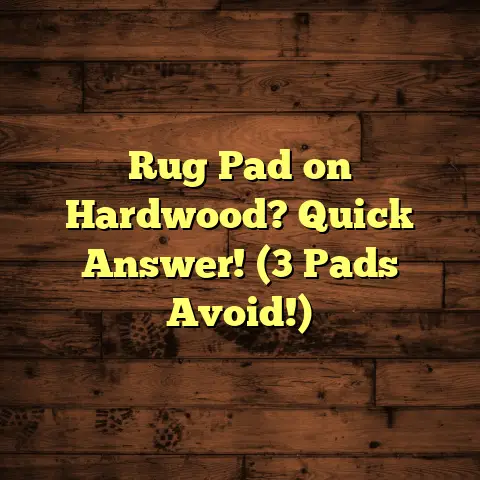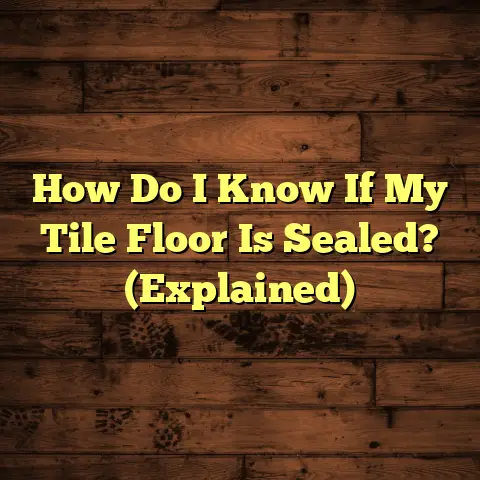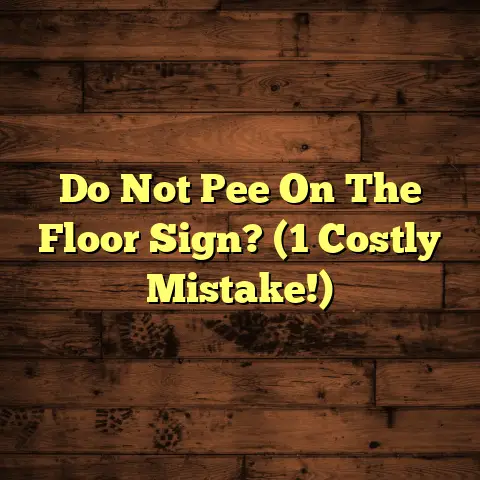Restore Tile Floors Like A Pro? (5 Secret Steps)
(Image: A split image showing a dull, stained tile floor on the left and a gleaming, restored tile floor on the right.)
(Caption: From drab to fab! Restore your tile floors and take pride in the transformation. You won’t believe the difference!)
As a flooring contractor with over 15 years under my belt, I’ve seen it all when it comes to tile. From the gorgeous to the downright grimy. I’m going to let you in on a secret: You don’t always need to replace those tired, worn-out tile floors. You can restore them!I’m going to walk you through my 5 secret steps to restore tile floors like a total pro. Trust me, the satisfaction of bringing your tile back to life is incredible. Let’s dive in!
1. Understanding the Importance of Tile Floor Restoration
Tile floors. They’re everywhere.
From kitchens and bathrooms to hallways and patios. They’re durable, versatile, and can look absolutely stunning. But let’s face it: Life happens.
Dirt, spills, scratches, and grime can all take their toll, leaving your once-beautiful tile looking dull, stained, and just plain sad.
Think about it. Your floors are one of the first things people notice when they walk into a room. A well-maintained tile floor adds value, creates a welcoming atmosphere, and simply makes your space feel cleaner and more inviting.
But what happens when your tile starts to deteriorate?
- Aesthetic Impact: Dull, stained tile can make your entire home look dated and unkempt.
- Functional Issues: Cracks and chips can create tripping hazards and lead to water damage.
- Hygiene Concerns: Dirty grout harbors bacteria and mold, impacting indoor air quality.
Now, you might be thinking, “Okay, my tile looks bad. Time to rip it all out and start over!” But hold on! Replacement is expensive. It’s messy. And it’s often unnecessary.
Restoring your tile floors is a cost-effective alternative that can save you a ton of money and hassle. Plus, it’s a fantastic DIY project that’ll give you a real sense of accomplishment.
2. Step 1: Assessment of Tile Condition
Before you even think about grabbing a scrub brush, you need to assess the current state of your tile floor. This is like a doctor diagnosing a patient. You need to identify the problems before you can prescribe the cure.
Start by taking a good, hard look at your tile. I mean, really look.
- Overall Cleanliness: How dirty is the tile? Is it just surface grime, or are there embedded stains?
- Grout Condition: Is the grout discolored, cracked, or missing?
- Tile Damage: Are there any cracked, chipped, or loose tiles?
- Sealer Integrity: Is the existing sealer worn away, leaving the tile vulnerable to stains?
- Moisture Issues: Are there any signs of water damage, such as efflorescence (white, powdery deposits) or mold growth?
Here are some tools that I find invaluable during an assessment:
- Magnifying Glass: For getting a close-up look at grout lines and identifying hairline cracks.
- Moisture Meter: To check for hidden moisture issues under the tile.
- Bright Light: A strong flashlight or work light will help you spot stains and imperfections.
- Notebook and Pen: To document your findings and create a plan of action.
Identifying Specific Problems
- Cracks: Hairline cracks can often be repaired with epoxy. Larger cracks may indicate underlying structural issues.
- Chipped Tiles: Small chips can be filled with a color-matched repair compound. Larger chips may require tile replacement.
- Deeply Embedded Stains: These can be challenging to remove and may require specialized cleaning solutions.
- Grout Discoloration: Mild discoloration can often be cleaned. Severe discoloration may require grout removal and replacement.
- Loose Tiles: These need to be re-adhered to the subfloor to prevent further damage.
Pro Tip: Don’t underestimate the power of a good sniff test! Musty odors can indicate mold growth, which needs to be addressed before you start any restoration work.
3. Step 2: Gathering the Right Materials and Tools
Okay, you’ve assessed the damage. Now it’s time to gather your arsenal. Using the right materials and tools is crucial for achieving professional-looking results. Don’t skimp on quality here. It’ll save you time and frustration in the long run.
Essential Materials:
- Tile Cleaner: Choose a cleaner specifically designed for your type of tile (ceramic, porcelain, natural stone). Avoid harsh chemicals that can damage the tile or grout.
- Grout Cleaner: A good grout cleaner is essential for removing dirt, grime, and stains from grout lines.
- Tile Sealer: Protects your tile and grout from future stains and water damage. Choose a sealer appropriate for your tile type.
- Grout Sealer: Provides an extra layer of protection for your grout, preventing discoloration and mold growth.
- Epoxy Repair Kit: For repairing small cracks and chips in tile.
- Grout Repair Kit: For repairing damaged or missing grout.
- Color-Matched Caulk: For sealing around fixtures and edges.
Essential Tools:
- Scrub Brush: A stiff-bristled brush is essential for scrubbing tile and grout.
- Grout Brush: A smaller, more precise brush for cleaning grout lines.
- Sponges: For wiping up excess cleaner and water.
- Buckets: For holding clean water and cleaning solutions.
- Steam Cleaner: A steam cleaner can be incredibly effective for deep cleaning tile and grout.
- Grout Removal Tool: For removing old or damaged grout.
- Grout Float: For applying new grout.
- Tile Scraper: For removing adhesive from loose tiles.
- Safety Glasses: Protect your eyes from splashes and debris.
- Gloves: Protect your hands from harsh chemicals.
- Knee Pads: Trust me, your knees will thank you.
Choosing High-Quality Products
I can’t stress this enough: Choose high-quality products! Cheap cleaners and sealers can damage your tile and grout, leading to even bigger problems down the road.
Look for products that are specifically designed for tile and grout. Read reviews and ask for recommendations from other DIYers or flooring professionals.
Pro Tip: Always test your cleaning solutions and sealers in an inconspicuous area before applying them to the entire floor. This will help you ensure that they don’t damage or discolor your tile.
4. Step 3: Deep Cleaning the Tile Floors
Alright, you’ve got your materials and tools. Now it’s time to get down and dirty (literally). Deep cleaning is the foundation of any successful tile restoration project. You need to remove all the dirt, grime, and stains before you can start repairing and sealing.
Step-by-Step Guide:
- Sweep or Vacuum: Remove any loose dirt and debris from the floor.
- Pre-Treat Stains: Apply a stain remover to any stubborn stains and let it sit for the recommended time.
- Apply Tile Cleaner: Follow the manufacturer’s instructions for applying the tile cleaner.
- Scrub the Tile: Use a scrub brush to scrub the tile and grout lines. Pay extra attention to areas with heavy staining or grime.
- Rinse Thoroughly: Rinse the floor with clean water to remove all traces of cleaner.
- Dry the Floor: Use a clean towel or mop to dry the floor.
Recommended Techniques for Different Tile Types:
- Ceramic and Porcelain Tile: These are generally the easiest to clean. You can use a variety of cleaners, including all-purpose cleaners, tile cleaners, and even a mixture of vinegar and water.
- Natural Stone Tile (Granite, Marble, Limestone): These are more porous and require special care. Use a cleaner specifically designed for natural stone. Avoid acidic cleaners like vinegar, which can damage the stone.
- Grout Cleaning: For heavily soiled grout, use a grout brush and a grout cleaner. You can also try a steam cleaner for extra cleaning power.
Using Cleaning Solutions and Tools Properly:
- Always follow the manufacturer’s instructions.
- Don’t use abrasive cleaners or scrub brushes on delicate tile.
- Rinse thoroughly to remove all traces of cleaner.
- Wear gloves and safety glasses to protect yourself from harsh chemicals.
Achieving a Clean Surface Before Restoration Work:
A clean surface is essential for proper adhesion of sealers and repair compounds. If the tile is still dirty, the sealers and repair compounds won’t bond properly, and your restoration work will be less effective.
Pro Tip: For really tough stains, try making a paste of baking soda and water. Apply the paste to the stain, let it sit for a few minutes, and then scrub with a brush.
5. Step 4: Repairing Damaged Tiles and Grout
Now that your tile is sparkling clean, it’s time to address any damage. Cracks, chips, and missing grout not only look bad, but they can also lead to further damage if left unrepaired.
Repairing Common Tile Damage:
- Cracks: For hairline cracks, use an epoxy repair kit. Clean the crack thoroughly, apply the epoxy, and let it cure according to the manufacturer’s instructions.
- Chips: For small chips, use a color-matched repair compound. Apply the compound to the chip, smooth it out, and let it dry.
- Missing Pieces: If a tile is completely missing, you’ll need to replace it. Remove the old adhesive, apply new adhesive, and set the new tile in place.
Re-Grouting Tiles:
- Remove Old Grout: Use a grout removal tool to carefully remove the old grout. Be careful not to damage the surrounding tiles.
- Clean the Grout Lines: Vacuum out any debris from the grout lines.
- Mix New Grout: Follow the manufacturer’s instructions for mixing the new grout.
- Apply New Grout: Use a grout float to apply the new grout to the grout lines.
- Remove Excess Grout: Use a damp sponge to remove excess grout from the tile surface.
- Cure the Grout: Let the grout cure according to the manufacturer’s instructions.
- Seal the Grout: Apply a grout sealer to protect the grout from future stains and water damage.
Color Matching and Sealant Application:
- Color Matching: When repairing tile or grout, it’s important to match the color as closely as possible. Take a sample of your existing tile or grout to the hardware store to find a matching product.
- Sealant Application: Apply a bead of color-matched caulk around fixtures and edges to seal out water and prevent mold growth.
Pro Tip: When removing old grout, use a shop vacuum to suck up the dust. This will help keep the dust from spreading throughout your home.
6. Step 5: Sealing and Protecting Your Tile Floors
You’ve cleaned, you’ve repaired. Now it’s time to protect your investment. Sealing your tile floors is like applying a protective coating to your car. It helps prevent future stains, water damage, and wear and tear.
Benefits of Sealing Tile Floors:
- Protects against stains: Sealer creates a barrier that prevents spills and stains from penetrating the tile and grout.
- Prevents water damage: Sealer repels water, preventing it from seeping into the tile and grout and causing mold growth.
- Extends the life of your tile: Sealer protects your tile from scratches and wear, extending its lifespan.
- Makes cleaning easier: Sealed tile is easier to clean because dirt and grime can’t penetrate the surface.
Detailed Walkthrough of the Sealing Process:
- Clean the Floor: Make sure the floor is clean and dry before applying sealer.
- Apply Sealer: Use a paint brush, roller, or sponge to apply a thin, even coat of sealer to the tile and grout.
- Let it Penetrate: Allow the sealer to penetrate the tile and grout for the recommended time.
- Wipe off Excess Sealer: Use a clean towel to wipe off any excess sealer from the tile surface.
- Dry the Floor: Let the floor dry completely before walking on it.
Drying Times and Application Techniques:
- Drying Times: Drying times vary depending on the type of sealer you use. Follow the manufacturer’s instructions.
- Application Techniques: Apply the sealer in thin, even coats. Avoid applying too much sealer, which can cause it to puddle and leave a sticky residue.
Maintenance Tips to Prolong the Life of Restored Tile Floors:
- Regular Cleaning: Clean your tile floors regularly with a mild cleaner.
- Avoid Abrasive Cleaners: Don’t use abrasive cleaners or scrub brushes, which can damage the sealer.
- Wipe up Spills Immediately: Wipe up spills immediately to prevent staining.
- Re-Seal Periodically: Re-seal your tile floors every 1-2 years to maintain their protection.
Pro Tip: Apply multiple thin coats of sealer rather than one thick coat. This will provide better protection and prevent the sealer from peeling or cracking.
Conclusion
So there you have it: my 5 secret steps to restoring tile floors like a pro!
- Assess the Tile Condition
- Gather the Right Materials and Tools
- Deep Clean the Tile Floors
- Repair Damaged Tiles and Grout
- Seal and Protect Your Tile Floors
It might seem like a lot of work. But trust me, the results are worth it.
Imagine walking into your kitchen or bathroom and seeing those gleaming, restored tile floors.
You’ll feel a sense of pride and accomplishment knowing that you did it yourself. Plus, you’ll have saved a ton of money by avoiding costly replacement.
So go ahead, grab your tools, and get started! You’ve got this. And remember, I’m always here to answer any questions you might have.
Happy restoring!





